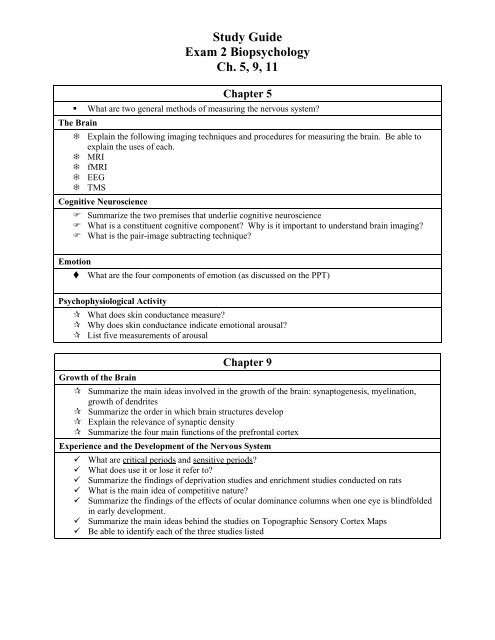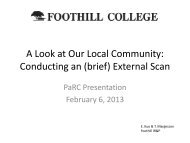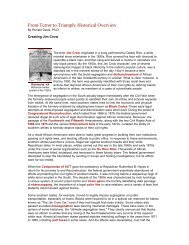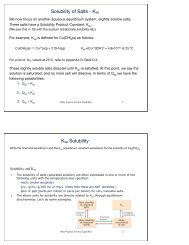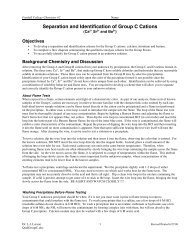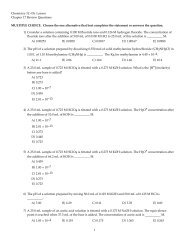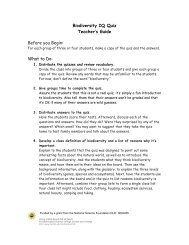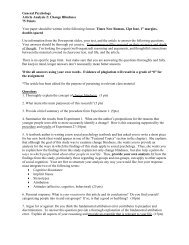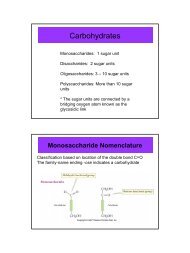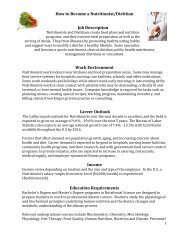Study Guide Exam 2 Biopsychology Ch. 5, 9, 11
Study Guide Exam 2 Biopsychology Ch. 5, 9, 11
Study Guide Exam 2 Biopsychology Ch. 5, 9, 11
You also want an ePaper? Increase the reach of your titles
YUMPU automatically turns print PDFs into web optimized ePapers that Google loves.
<strong>Study</strong> <strong>Guide</strong><br />
<strong>Exam</strong> 2 <strong>Biopsychology</strong><br />
<strong>Ch</strong>. 5, 9, <strong>11</strong><br />
<strong>Ch</strong>apter 5<br />
What are two general methods of measuring the nervous system?<br />
The Brain<br />
Explain the following imaging techniques and procedures for measuring the brain. Be able to<br />
explain the uses of each.<br />
MRI<br />
fMRI<br />
EEG<br />
TMS<br />
Cognitive Neuroscience<br />
Summarize the two premises that underlie cognitive neuroscience<br />
What is a constituent cognitive component? Why is it important to understand brain imaging?<br />
What is the pair-image subtracting technique?<br />
Emotion<br />
What are the four components of emotion (as discussed on the PPT)<br />
Psychophysiological Activity<br />
What does skin conductance measure?<br />
Why does skin conductance indicate emotional arousal?<br />
List five measurements of arousal<br />
Growth of the Brain<br />
<strong>Ch</strong>apter 9<br />
Summarize the main ideas involved in the growth of the brain: synaptogenesis, myelination,<br />
growth of dendrites<br />
Summarize the order in which brain structures develop<br />
Explain the relevance of synaptic density<br />
Summarize the four main functions of the prefrontal cortex<br />
Experience and the Development of the Nervous System<br />
What are critical periods and sensitive periods?<br />
What does use it or lose it refer to?<br />
Summarize the findings of deprivation studies and enrichment studies conducted on rats<br />
What is the main idea of competitive nature?<br />
Summarize the findings of the effects of ocular dominance columns when one eye is blindfolded<br />
in early development.<br />
Summarize the main ideas behind the studies on Topographic Sensory Cortex Maps<br />
Be able to identify each of the three studies listed
Types of Memory<br />
Short-term<br />
Long-term<br />
Explicit<br />
Implicit<br />
Semantic<br />
Episodic<br />
Structures and Locations<br />
<strong>Ch</strong>apter <strong>11</strong><br />
List the structures that are removed in a medial temporal lobectomy<br />
What does the Case of H.M. contribute to our understanding of memory?<br />
a. What is retrograde amnesia?<br />
b. What is anterograde amnesia?<br />
Be able to summarize the effects that a medial temporal lobectomy has on memory? Be able to<br />
explain what this tells us about types of memories and the biological structures of memories.<br />
Be able to summarize the different types of memories stored in the following structures<br />
a. Amydala<br />
b. Prefrontal Cortex<br />
c. Cerebellum<br />
Memory Consolidation<br />
Be able to explain all of the main ideas behind memory consolidation.<br />
What is an engram?<br />
Provide a summary of Hebb’s Theory.<br />
Explain the idea behind reverberation activity.<br />
Be able to summarize Pinel’s 1969 study on electroconvulsive shocks on rats. Be able to explain<br />
the significance of the findings to theory of memory consolidation.<br />
Summarize the standard consolidation theory<br />
Summarize the evidence for memory consolidation (as discussed on the PPT)<br />
Memory Reconsolidation<br />
Explain the main idea behind memory reconsolidation


